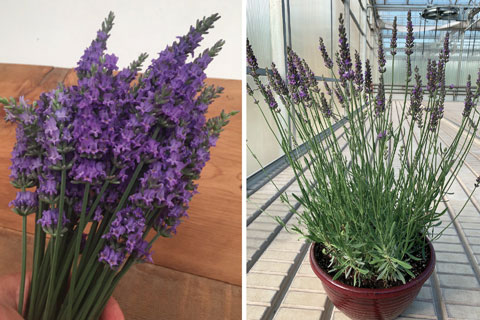11/1/2021
A Sensational! Lavender for Your Lineup
Maria Zampini

There are plenty of lavenders on the market, but only one is truly sensational—not just in name, but in flowers and foliage. Sensational! Lavender has prolific, long-lasting, fragrant, 4-in. blooms on a well-branched, compact plant. Not to be outdone, the leaves are broad sized and an eye-catching silver that stand out even when the plant isn’t in flower.
Here are cultural best practices from Lloyd Traven of Peace Tree Farm and Dr. Rick Grazzini of Garden Genetics, who discovered Sensational! Lavender.
Size: Finish in pots from 1 quart through 2 gallon.
Watering: Drainage is critical, especially during establishment and vernalization. Avoid wet feet in production; really dry is best. It’s highly recommended to wait an extra day or two whenever you feel it’s time to irrigate. Allowing drying almost to wilt will force roots to search. Unless it’s likely to expire by the next morning, it’s better re-assess the following day. Once plants break dormancy, regular irrigation to keep soil slightly moist will speed up growth and finishing. Plants coming into bloom will use more water than other stages.
Soil: Use an open, aerated soil. Some growers are also successful with 100% peat mixes.
Fertilization: Low fertility levels recommended; feed at 100 ppm nitrogen, increasing to 125 ppm during active growth. Low phosphorus is key; excess phosphorus interferes with mycorrhizal interaction, which is crucial to lavenders. Lavenders look for calcium, so an alkaline pH is important. Consult with a fertilizer specialist to establish proper Ca/Mg ratio, such as Dr. Curtis Swift of Mesa Lavender Farms or Dr. Cari Peters of JR Peters Lab.
Vernalization: For spring blooms, vernalization is required. Night temperature around 50F (10C) is critical; six weeks minimum, eight to 10 weeks far better, and the colder the better. Again, 50F will be the marginal temperature. Sensational! tends to grow roots before the top takes off and flushes, so establishment and bulking makes the crop better. It’s suggested to bulk in the fall, then try to keep at 35F (1.6C) all winter and let normal warmup bring them in to bloom, running them really dry. Move vernalized plants outside once temperatures increase above the low 20s. Consider row covers if colder.
Forcing: After vernalization, it’s possible to force blooms for programs and promotions. Plants with 10-plus weeks of vernalization are best. Increase temperatures to 60F (15C) slowly; give long days if possible. Increase irrigation once plants show dormancy break. You’ll know that blooming cycle is happening when plants start to lose the silver color on the tips and new growth begins “greening up.” Depending on light and temperature, it’s a minimum six weeks to force, eight weeks to be safe, but best show and quality is at 10 weeks with cooler temperature and highest light. Don’t increase feed rates, but do increase irrigation as plants flush. The breeder doesn’t use PGRs nor does it require any PGRs because of the extremely strong stems. However, Dr. Joyce Latimer at Virginia Tech has recommended this if there’s a need for a specific height for cart shipping.
Timing: Dependent upon size of rooted liner, but obviously, larger can be faster. A 102 or 72 needs about six weeks to finish a spring pot, but can be grown pot-to-pot the entire time for a non-blooming pot. Larger field plugs (a size large enough to go directly into a field for cut flowers and oil producers) will take eight to 10 weeks in a pot larger than a 1 gallon.
Pests: Aphids and spittle bugs may show up, but are a non-issue. Thrips are infrequent. There’s experience with a caterpillar that will roll the tips at times; they’re quickly evident and easy to eliminate utilizing DiPel (Bt).
Disease: Prevention and exclusion of water molds (Pythium, Phytophthora) are paramount. The breeder has used Cease, Regalia, RootShield, RootShield Plus and Actinovate, among others. Conventional growers can use prophylactic drenches, like Truban. The breeder isn’t a proponent of mefenoxam products like Subdue Maxx, despite some university research, as he sees consistent reports of strong Phytophthora resistance to this specific chemical in the north.
Sensational! Lavender provides uniform, consistent propagation, is programmable and is grower-friendly (doesn’t die like other lavenders). These attributes and more are making it a go-to for both field growers and perennial producers. GT
Maria Zampini is the owner of UpShoot LLC, a boutique horticultural marketing firm specializing in new plant introductions and gardening-related products. She writes for consumer magazines and horticultural trade journals, and is the co-author of “Garden-pedia: An A-Z Guide to Gardening Terms.” She can be reached at maria@upshoothort.com.